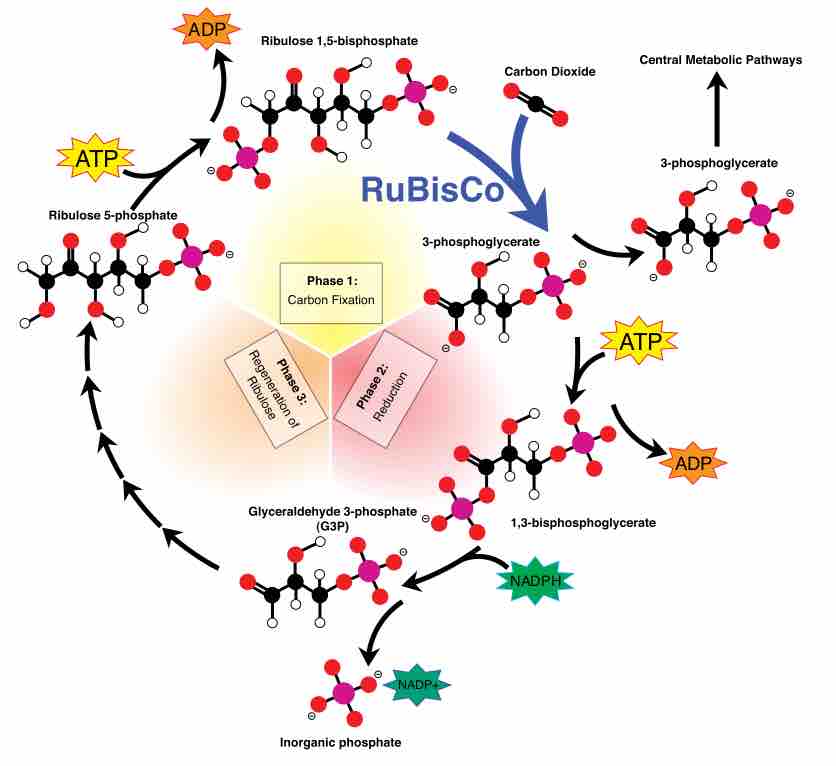The Calvin Cycle is characterized as a carbon fixation pathway. The Calvin Cycle is also referred to as the reductive pentose phosphate cycle or the Calvin-Benson-Bassham cycle. The process of carbon fixation involves the reduction of carbon dioxide to organic compounds by living organisms. The Calvin cycle is most often associated with carbon fixation in autotrophic organisms, such as plants, and is recognized as a dark reaction. In organisms that require carbon fixation, the Calvin cycle is a means to obtain energy and necessary components for growth. Some examples of microorganisms that utilize the Calvin cycle include cyanobacteria, purple bacteria, and nitrifying bacteria. Specifically, the Calvin cycle involves reducing carbon dioxide to the sugar triose phosphate, most commonly known as glyceraldehyde 3-phosphate (GAP). Throughout the Calvin Cycle, there are numerous intermediate molecules made which are consistently withdrawn and utilized to create cellular material and participate in cellular processes . The Calvin cycle can be divided into three major phases which include: Phase 1: carbon fixation; Phase 2: reduction; and Phase 3: regeneration of ribulose . The following is a brief overview of the intermediates created during the Calvin cycle.

The Calvin Cycle
An overview of the Calvin Cycle.
Phase 1: Carbon Fixation Intermediates
During phase 1 of this cycle, the CO2 molecule is incorporated into one of two 3-phosphoglycerate molecules (3-PGA). This process requires the enzyme RuBisCO and both ATP and NADPH. Once 3-PGA is formed, one of two molecules formed continues into the reduction phase (phase 2). The additional 3-PGA is utilized in additional metabolic pathways such as glycolysis and gluconeogenesis. The structure of 3-PGA allows it to be combined and rearranged to form sugars which can be transported to additional cells or stored for energy.
Phase 2: Reduction
During phase 2 of this cycle, the newly formed 3-PGA undergoes phosphorylation by the enzyme phosphoglycerate kinase which utilizes ATP. The result of this phosphorylation is the production of 1,3-bisphosphoglycerates and ADP products. The ADP product that is produced via the breakdown of ATP will be utilized in additional pathways and be converted back into ATP. The inter conversions of ATP to ADP and ADP to ATP is a key process in supplying energy in numerous processes. This energy is necessary for cellular growth and metabolic processes.
Once the bisphosphoglycerate molecules are formed, they must be converted and further reduced to GAP by NADPH. The intermediate of this product is the conversion of NADPH to NADP+ and an inorganic phosphate ion. NADP+ is a coenzyme which is necessary for the function of NADPH. The functions that require NADP+ include anabolic reactions such as lipid and nucleic acid synthesis. The inorganic phosphate ion is often a result of regulatory metabolic processes. The phosphate ions are used in processes such as buffering cells, conversions of AMP/ADP to ATP and production of materials involved in structure such as bone and teeth. It is important to note that these intermediates or products (inorganic phosphate, NADP+ and ADP) processed by phase 2 are often regenerated back into the cycle.
Phase 3: Regeneration of Ribulose
The GAP molecules at this point are the end product of the Calvin cycle, which is responsible for reducing carbon to a sugar form. However, additional GAP molecules that are formed will be converted to ribulose-1,5-bisphosphate (RuBP), which is responsible for the conversion of CO2 to 3-PGA in phase 1, via numerous steps. The G3P, which is destined to exit the cycle, will be used for carbohydrate synthesis and additional pathways.